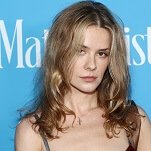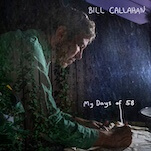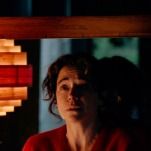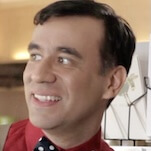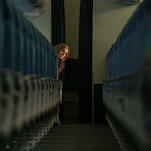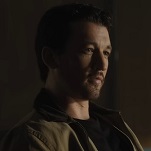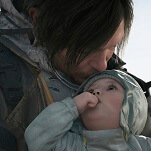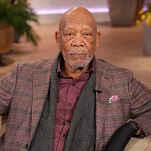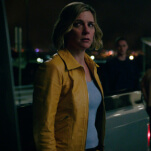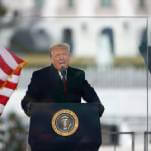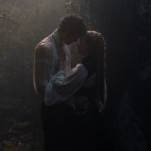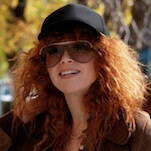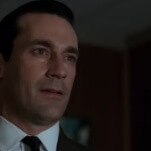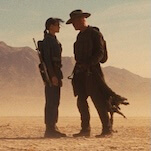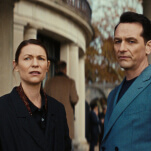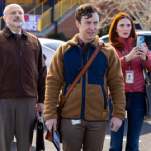Examining scenes in isolation can be tricky—in movies, as in life, context is everything. A scene’s impact often depends upon preceding events, which is why this column generally includes one quick paragraph that sets up The Story So Far. Sometimes, though, a scene dazzles because it’s in such stark, startling opposition to the movie surrounding it—a radical change of style and/or tone that nobody could possibly have seen coming. I’ve chosen for this installment a surreal setpiece from The Small Back Room (1949), one of many terrific films made by Michael Powell and Emeric Pressburger, a team well known for its extravagant flights of fancy (The Red Shoes, The Life And Death Of Colonel Blimp). But while I feel confident that you’ll enjoy these few minutes even if you’ve never seen the movie (which only came out on Region 1 DVD a couple of years ago), there’s no question that they’re far more effective arriving, as they do, smack in the middle of an otherwise resolutely realistic World War II drama.
So… The Story So Far. Plot-wise, all you really need to know is that The Small Back Room concerns the low-key exploits of a group of British… well, today we’d call them tech nerds or something, I guess. Chief among these is David Farrar, a brilliant scientist with a tin right leg (we can assume he lost it earlier in the war) that causes him nearly constant agony, and for which he takes a supply of what the characters in the movie all call “dope,” though I don’t imagine it’s what we mean today by that word. What Farrar really wants, however, is a drink, which he won’t allow himself because (it’s implied) he’s aware that he’s an alcoholic. Nonetheless, he keeps one bottle of whiskey in his apartment, planning to open it on the day the war ends; he and his girlfriend, Kathleen Byron, have a masochistic little routine in which she offers him the bottle specifically so he can refuse it. On this particular rainy evening, however, Byron isn’t around (he’ll “be damned” if he’ll call her), the pain of his false leg is unbearable, and that unopened whiskey bottle proves, shall we say, unusually tempting.
Pretty out there, no? To my mind, this sequence is more effective than anything in Billy Wilder’s The Lost Weekend, which was released a few years earlier. More to the point, though, you would expect to see something fairly surreal in a movie that’s explicitly about a man’s struggle with alcoholism—The Lost Weekend turns lurid almost immediately. The Small Back Room, by dramatic contrast, is almost aggressively ordinary until this moment. (Not a criticism, by the way—the entire film is first-rate, albeit in a less ostentatious way.) So committed are Powell and Pressburger to naturalism that entire scenes are designed around mundane details: In one memorable instance, a lengthy conversation between Farrar and one of his colleagues, whose marital problems are affecting his work, is punctuated by the loud footfalls of other colleagues walking overhead, as this fellow’s “office” is located in what amounts to a cellar directly beneath a frequently trod-on grate. After nearly an hour of this emphasis on drab reality, the sudden shift to expressionism is designed to catch viewers utterly off-guard.
Accordingly, Powell and Pressburger make the transition in stages. The first sign of anything odd occurs when Farrar, hearing a noise he assumes is Byron, heads for the front door; before cutting to follow him, the camera pushes slightly forward into the mirror he’d been standing in front of as he put on his tie. This isn’t remotely jarring—we’re just following his progress through the apartment—but the use of the mirror, though hardly unusual, is still more formally self-conscious than P&P have been hitherto in this film, certainly enough so that attentive viewers may raise an eyebrow. Like the shot of the cat on the bed—which seems vaguely suggestive of a dream state, though I can’t articulate why (beds are for sleeping + cats are almost always asleep?)—the deliberate push into the mirror subtly foreshadows the looking-glass imagery to follow. As yet, however, we have no reason to believe that we aren’t still watching the same richly workaday movie we’ve long since settled comfortably into.
But it’s hard not to notice when Powell & Pressburger start foregrounding the whiskey bottle in nearly every shot. If you don’t know what’s coming, that first close-up feels a little crass, as if the filmmakers have abruptly decided that we’re idiots who require visual coddling. But it’s followed by a truly lovely effect (which I’m surprised didn’t become commonplace—I can’t recall other examples offhand) in which Farrar, having switched off the lights, peers out the window at the storm but can only see the reflection of the bottle on the table behind him, then proceeds to kill the reflection with his shadow as he turns his attention back to it. (I could perhaps have lived without the theremin kicking in at this moment, but it was in vogue at the time—see also, in fact, the DTs sequences in The Lost Weekend.) At this point, it’s clear that the boys who made The Red Shoes one year earlier are in the house, demonstrating a facility with monochrome every bit as impressive as their bold use of Technicolor.
All the same, it’s a droll moment when Farrar leaves the frame and then returns, for no really defensible narrative or psychological reason, with a small clock, which he places next to the bottle. At which point the movie briefly and gloriously goes all-out bugfuck. We get a looming insert of Byron’s photograph, which had been previously visible on numerous occasions, but never before seemed to have such a mocking air. Farrar’s performance, which had been fairly naturalistic in a clipped, direct sort of way, suddenly looks like an homage to the silent era, complete with clenched fists and silent screams. Not that we’d be able to hear his screams over the increasingly insistent movement of the clock’s gears, which get multiplied by two dozen. Grotesque forced perspective, bizarre angles (dig the shot of Farrar slumped in profile, with the table sloped downward toward him, its leg a Dr. Caligari corkscrew), high-contrast lighting—P&P pull out all the stops, reportedly in an attempt to outdo Salvador Dalí’s famed dream sequence in Hitchcock’s Spellbound (which I’d say they achieved handily).
And then, as abruptly as it began, the sequence ends, collapsing along with its hero. (For the record, Byron finally shows up to save the day immediately after this clip ends.) And The Small Back Room, having apparently satisfied its own undeniable craving, immediately returns to quiet stoicism, concluding with a remarkable but altogether unemphatic setpiece in which Farrar disables a German bomb in 17 minutes of excruciating real time. Like a brief thunderstorm in the midst of an otherwise beautiful day, this amazing scene, which occurs exactly halfway through the film, makes me more conscious of the glory it interrupts, while at the same time being a humdinger in its own right. Believe it or not, critics of the day singled it out as the movie’s low point, annoyed that Powell and Pressburger (whose work they generally disparaged for being overly flashy, and hence insufficiently British) had reverted to type amid what they considered a welcome display of stylistic restraint. Pity Farrar crushed all that dope at the height of his anguish—those tone-deaf journos clearly could have used it.

